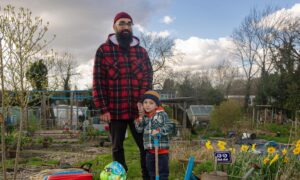
On Dads Lane, where several Birmingham suburbs meet, there is a gap in the houses, no wider than a driveway. If you didn’t know what was hiding in there, you would walk straight past. It is a brisk, bright Sunday in late March, and behind the gate, a narrow road stretches out into a busy haven of growth and greenery. The city centre is less than four miles away, but it might as well be on the moon. After a long, wet winter, the sun is out, people are digging, mowing and cutting, and everyone has something to say about the badgers.
“Men’s piss!” I’m having coffee in the pavilion with John Beynon, a warm, 71-year-old Welshman, who has been chair of the allotments since last summer (“I’m not a president! That makes me think I’m a Trumpian!”), and secretary Bryan Foster, 60, who opens his jacket to reveal a COR-BYN T-shirt, in the Run-DMC font. The allotments got national lottery funding a few years ago, and they put up this hub, which will host the monthly Sunday afternoon poetry reading later, as well as a compost toilet next door. They also paved the road and built two disability plots. Apparently, the only thing that will deter a hungry badger from nibbling the crops is men’s urine. They joke that they might start selling it in bottles at the next open day.
Birmingham has a vibrant, multicultural, transgenerational allotment community. The Birmingham Allotment Project has spent the last three years documenting it, holding an exhibition last year at the Birmingham Library and building a wonderful website stuffed with oral histories, case studies and photographs. According to the council, there are nearly 7,000 plots in the city, across 113 different sites, the most of any local authority in the UK. Each has its own character, and over the course of the day I start to get the gossip. There is talk of sites that are neater, quieter, boozier, but Dads Lane is proud of its identity. “I put a net over my cherry tree one year, but it just looked horrible,” says Bryan. “I thought, bloody let the birds have the cherries. I don’t need them.”
